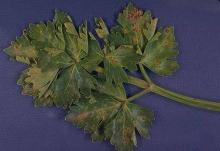Cause Septoria apiicola (syn. = S. apiis, = S. apii-graveolentis), a fungus. The disease overwinters on dead celery plant parts. The fungus is introduced in plantings primarily through infected seed. Fungus in the seed dies within 2 years; thus, seed should be pathogen-free after that. The name "late blight" is deceptive because infections frequently occur early in the season, a common problem in western Washington and British Columbia. The disease can be spread by water, equipment, and workers; if a field is infected with Septoria, do not work in it until the foliage is dry.
Symptoms Small, light yellow spots develop on leaves and petioles, gradually turning brown. Spots vary in shape and may coalesce if numerous. Minute, thickened, black dots (pycnidia) appear, containing spores of the fungus. Seriously infected leaves die. Symptoms on petioles are similar to those on leaves.
Cultural control
- Treat 1- to 2-year-old seed in water at 118°F for 30 min, or use older seed as for early blight.
- Clean up propagation area thoroughly to ensure no residue remains from the previous crop.
- Plow down crop refuse promptly after harvest.
- Rotate both seedbeds and production fields so that celery is not grown in the same place 3 or 4 years in a row.
- Do not spread crop residues on production fields.
- Increase spacing between rows and reduce planting densities to improve air movement within the field.
- In British Columbia, varieties Pilgrim, Tendercrisp, and T.U. 52-70 HK were resistant; Deacon was intermediate; Bishop and T.U. 52-70 were susceptible in observations over two (2) growing seasons.
Chemical control
- Chlorothalonil (Group M5) formulations are labeled.
- Bonide Fung-onil is available for home gardens. H
- Bravo WeatherStik at 2 to 3 pints/A starting when transplants are set in field and repeat on 7-day intervals. 12-hr reentry.
- Echo 720 at 1 to 1.5 pints/A on 3- to 5-day intervals or at 2 to 3 pints/A on 7-day intervals. Preharvest interval is 7 days. 12-hr reentry.
- Copper products (Gorup M1) used for other foliar diseases will also help to control late blight.
- Bonide Liquid Copper is available for home gardens. H
- Cueva at 0.5 to 2 gal/100 gal water on 7- to 10-day intervals. May be applied on the day of harvest. 4-hr reentry. O
- Cuprofix Ultra 40 Disperss at 1.25 lb/A on 7- to 14-day intervals. 48-hr reentry.
- Kocide 2000 at 1.5 lb/A or Kocide 3000 at 0.75 to 1.5 lb/A on 7-day intervals. 48-hr reentry. O
- Liqui-Cop at 2 to 3 teaspoons/gal water. H
- Nu-Cop 50 DF at 2 lb/A on 7-day intervals. 48-hr reentry. O
- Previsto at 1 to 2 quarts/A on 7-day intervals. 48-hr reentry. O
- Demethylation-inhibiting (DMI) Fungicides (Group 3) are labeled for use. Alternate or tank-mix with a non-Group 3 fungicide for resistance management.
- Bumper 41.8 EC at 4 fl oz/A on 7-day intervals. Preharvest interval is 14 days. 12-hr reentry.
- PropiMax EC at 4 fl oz/A on 7-day intervals. Do not apply within 14 days of harvest. 12-hr reentry.
- Rhyme at 5 to 7 fl oz/A. Preharvest interval is 7 days. 12-hr reentry.
- Tilt at 4 fl oz/A on 7-day intervals. Do not apply within 14 days of harvest. 12-hr reentry.
- Topaz at 4 fl oz/A on 7-day intervals. Preharvest interval is 14 days. 12-hr reentry.
- Fontelis (Group 7) at 14 to 24 fl oz/A on 7- to 14-day intervals. Do not make more than two (2) sequential applications before alternating to a labeled fungicide with a different mode of action (non-Group 7). Preharvest interval is 3 days. 12-hr reentry.
- Miravis Prime (Group 7 + 12) at 9.2 to 13.4 fl oz/A on 7- to 10-day intervals. Do not make more than two (2) applications before alternating to a fungicide in different FRAC groups (non-Group 7 and non-Group 12). Preharvest interval is 0 days. 12-hr reentry.
- Strobilurin fungicides (Group 11) are labeled for use. Do not make more than one (1) application of a Group 11 fungicide before alternating to a labeled fungicide with a different mode of action.
- Aftershock at 5.7 fl oz/A on 7- to 10-day intervals. Do not apply within 3 days of harvest. 12-hr reentry.
- Cabrio EG at 12 to 16 oz/A on 7- to 14-day intervals. Preharvest interval is 0 days. 12-hr reentry.
- Evito 480 SC at 5.7 fl oz/A on 7- to 10-day intervals. Preharvest interval is 3 days. 12-hr reentry.
- Quadris Flowable at 9 to 15.5 fl oz/A or Quadris Opti at 2.4 to 3.7 pints/A on 7- to 14-day intervals. Quadris Flowable may be applied the day of harvest. Preharvest interval is 7 days for Quadris Opti. 4-hr reentry for Quadris Flowable, 12-hr reentry for Quadris Opti.
- Quilt Xcel at 14 fl oz/A on a 7- to 10-day interval. Do not apply within 14 days of harvest. 12-hr reentry.
- Trilogy at 0.5% to 1%. Not labeled for use in Oregon. Do not use above 90°F or when plants are under heat or moisture stress. Do not use when foliage is wet as good coverage is essential. Poor control as a stand-alone product. Preharvest interval is 0 days. 4-hr reentry. O
Reference Lacy, M.L. 1994. Influence of wetness periods on infection of celery by Septoria apiicola and use in timing sprays for control. Plant Disease 78:975-979.


